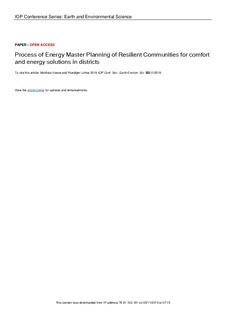| dc.contributor.author | Haase, Matthias | |
| dc.contributor.author | Lohse, Ruediger | |
| dc.date.accessioned | 2019-11-06T05:56:53Z | |
| dc.date.available | 2019-11-06T05:56:53Z | |
| dc.date.created | 2019-11-05T08:16:53Z | |
| dc.date.issued | 2019 | |
| dc.identifier.issn | 1755-1307 | |
| dc.identifier.uri | http://hdl.handle.net/11250/2626750 | |
| dc.description.abstract | The paper explains the major steps in Energy Master Planning process. It proposes a definition of target goals. Then, a number of constraints have to be analyzed in order to be able to define site specific framing goals and associated limitations. This process will narrow the numerous design options down to those that offer an optimized fit to the local conditions and the objectives for the building or community. Based on the target definition a Baseline can then be developed. This consists of a snapshot of the current energy use situation. The baseline is one reference point used to evaluate alternative futures. Then Base Cases will be developed that extends the baseline into the future and includes already-funded renovation as well as planned construction and demolition activities. The base case is a future reference point for “business as usual.” Different alternatives – A selected set of scenarios that include different energy measures related to buildings, distribution systems, and generation systems will then developed. These scenarios are compared to the baseline for energy use change and to the Base Case for investment and operational costs. | en |
| dc.language.iso | eng | nb_NO |
| dc.publisher | IOP Publishing Ltd | nb_NO |
| dc.relation.ispartof | 1st Nordic conference on Zero Emission and Plus Energy Buildings | |
| dc.rights.uri | http://creativecommons.org/licenses/by/3.0 | * |
| dc.title | Process of Energy Master Planning of Resilient Communities for comfort and energy solutions in districts | nb_NO |
| dc.type | Conference object | nb_NO |
| dc.type | Journal article | nb_NO |
| dc.type | Peer reviewed | nb_NO |
| dc.description.version | publishedVersion | nb_NO |
| dc.rights.holder | © The authors | nb_NO |
| dc.subject.nsi | VDP::Teknologi: 500 | nb_NO |
| dc.source.volume | 352 | nb_NO |
| dc.source.journal | IOP Conference Series: Earth and Environmental Science (EES) | nb_NO |
| dc.identifier.doi | 10.1088/1755-1315/352/1/012019 | |
| dc.identifier.cristin | 1744008 | |
| dc.rights.license | CC BY 3.0 | |
| dc.source.articlenumber | 012019 | |
| cristin.unitcode | 7401,30,40,0 | |
| cristin.unitname | Arkitektur, byggematerialer og konstruksjoner | |
| cristin.ispublished | true | |
| cristin.fulltext | original | |
| cristin.qualitycode | 1 | |

